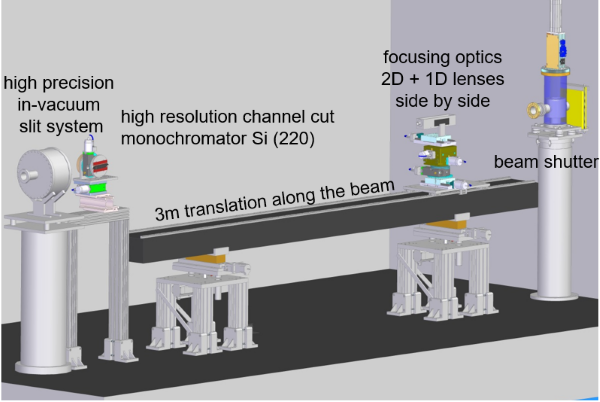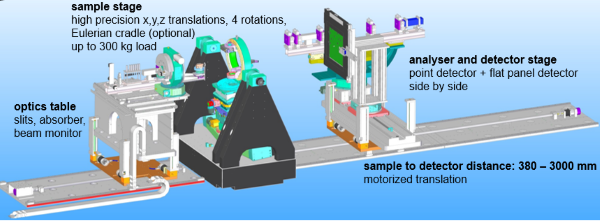Schematic of the optics hutch
Descriptions of sample environments and detectors available at the beamline are found on the sample environment and detector pages.
The standard equipment installed in the optics and experimental hutches are described below.
Optics hutch
The monochromator placed in OH1 consist of two bent Si(111) Laue crystals (the first one water-coooled) on Rowland geometry (35.36o asymmetric cut, triangularly shaped with base 35 mm, length 89 mm and each 1.25 mm thick) in fixed exit (horizontal deviation 21 mm) keeping the beam at 1400 mm height above the floor. The energy is tunable exactly 33 - 200 keV with this double crystal monochromator (DCM) in horizontal scattering geometry. At 80 keV the σ-sub-mm large beam showed an integrated flux of 5x1012 photons / sec. 0.2% bw. Both SBM and DCM had been custom-built by FMB-Oxford.
The focusing optics are placed in OH2. Here 2D and 1D compound refractive lenses (CRLs) are mounted on a translation table in the optics hutch, so the lense to sample distance can be changes by 3m.
The 2D lenses are individual machined Al lenses, which focus the beam down to 2 × 30 μm2. The focal distance is 4.5 – 7.5 m. The lenses are placed in a lense tank with room for max. 148 lenses. The acceptance of the lenses is approx 0.3 × 0.3 mm2.
The 1D lenses are dry-etched parabolic structures on Si wafer, which focus the beam down to 3 × 500 μm2. The focal distance 4.5 – 7.5 m with ~100 – 200 lenses. The acceptance of the 1D lenses is approx.. 0,8 × 0.5 mm2
Experimental hutch
Optics table
The optics table carries slits, absorbers and a beam monitoring diode.
Sample tower
The diffractometer consists of high precision x, y and z translations as well as 4 rotational degrees of freedom. It can carry loads up to 300 kg. This is the base for most experiments and can service a large variety of sample environments, available at the beamline or supplied by the users. The table is 40 × 40 cm2 and a Eulerian cradle can be mounted for larger sample movement. Dimensions for mounting of user equipment are available upon contact with beamline staff.
Several additional sample positioning devises (hexapod, rotation table etc.) are frequently used for scanning beam experiments f.ex. XRD-CT.
Detector stage
The movable detector stage has a dual detector setup, which allows for fast switching between point and area detectors during the experiment. The stage gives possible sample to detector distances of ~0.3 – 3 m. The point detector or small area detector can be used to scan q-space and for reflectivity measurements. The point detector setup has the possibility to include an analyzer crystal with tunable rocking width to adjust the resolution to the sample scattering properties. The area detectors described here can be mounted to access a large q-space in a single exposure.







